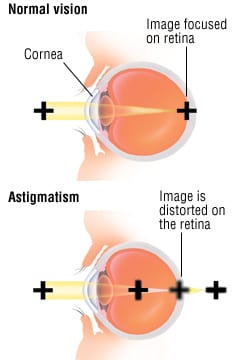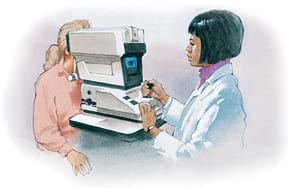Patient Basics: Astigmatism
Originally published by Harvard Health.
What Is It?
Astigmatism means that the cornea of the eye has an irregular shape, causing vision problems. The cornea is the clear covering over the lens and the iris. It protects these structures and helps to transmit light through the eye. The cornea is normally spherical, although in people with astigmatism, it may be shaped like a football or oval. This causes light to scatter instead of focus on a single point as it passes through the cornea, resulting in blurred vision.
Many people have some degree of astigmatism. In fact, it is rare to find a perfectly formed eye. Astigmatism is thought to be hereditary, so if you have astigmatism, chances are good your children will have it also. The condition often occurs with other vision conditions such as nearsightedness (myopia). Many people confuse astigmatism with “lazy eye” (amblyopia). They are not the same condition though severe astigmatism can contribute to amblyopia.
Symptoms
The most common symptom of astigmatism is blurred vision. Some people describe it as double vision but in only one eye. Some people with astigmatism develop eyestrain, squinting and headaches from working to focus on near or distant objects. People are born with astigmatism, but it may not be noticed until a child begins to attend school or learns to read.
Diagnosis
An ophthalmologist or an optometrist can diagnose astigmatism using a standard eye examination.
Expected Duration
Astigmatism is a lifelong condition unless it is treated. It may worsen slowly over time; more typically, it remains stable throughout life.
Prevention
Astigmatism cannot be prevented. It appears to run in families and is present from birth.
Treatment
It is possible to correct astigmatism using glasses, certain types of contact lenses or surgery. Glasses are a good, reliable choice. Patients who prefer contact lenses may find that they are limited to hard lenses. Soft lenses sometimes can be used, but they aren’t as effective for severe cases. Surgery may be a choice, especially for people who have dry eyes or other conditions that prohibit them from wearing corrective lenses. The most common type of surgery used to correct astigmatism is LASIK (laser in situ keratomileusis).
In LASIK, a small incision is made on the surface of the eye to create a small flap of tissue, which then is lifted up. A cool laser beam then is used to correct the irregular curvature seen in astigmatism. The flap is replaced, and recovery is usually quick and painless.
When To Call a Professional
You should call your doctor if you’re having trouble with blurred vision or headaches. You should schedule an eye appointment for your child if he or she complains of these symptoms, or if you notice a lot of squinting or eye rubbing.
Prognosis
Astigmatism is usually a stable condition. Astigmatism can be corrected with glasses, contact lenses or surgery. Sometimes astigmatism can be caused by other medical conditions, particularly problems of inflammation of the eyelids. Astigmatism that gets steadily worse over time may in fact be a condition called keratoconus. In keratoconus the cornea gets progressively thinner in one area and begins to bulge. These conditions may require more frequent doctor visits and treatment.
Additional Info
American Academy of Ophthalmology
P.O. Box 7424
San Francisco, CA 94120-7424
Phone: 415-561-8500
Fax: 415-561-8533
http://www.aao.org/news/eyenet/


